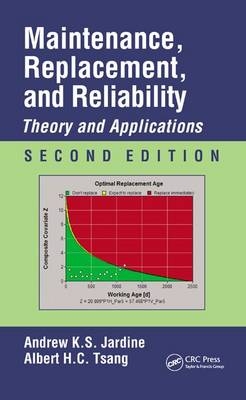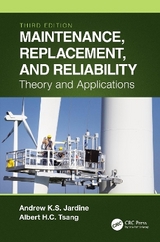
Maintenance, Replacement, and Reliability
Crc Press Inc (Verlag)
978-1-4665-5485-6 (ISBN)
- Titel erscheint in neuer Auflage
- Artikel merken
See What’s New in the Second Edition:
New Topics
The role of maintenance in sustainability issues
PAS 55, a framework for optimizing management assets
Data management issues, including cases where data are unavailable or sparse
How candidates for component replacement can be prioritized using the Jack-knife diagram
New Appendices
Maximum Likelihood Estimated (MLE)
Markov chains and knowledge elicitation procedures based on a Bayesian approach to parameter estimation
E-learning materials now supplement two previous appendices (Statistics Primer and Weibull Analysis)
Updated the appendix List of Applications of Maintenance Decision Optimization Models
Firmly based on the results of real-world research in physical asset management, the book focuses on data-driven tools for asset management decisions. It provides a solid theoretical foundation for various tools (mathematical models) that, in turn, can be used to optimize a variety of key maintenance/replacement/reliability decisions. It presents cases that illustrate the application of these tools in a variety of settings, such as food processing, petrochemical, steel and pharmaceutical industries, as well as the military, mining, and transportation (land and air) sectors.
Based on the authors’ experience, the second edition maintains the format that made the previous edition so popular. It covers theories and methodologies grounded in the real world. Simply stated, no other book available addresses the range of methodologies associated with, or focusing on, tools to ensure that asset management decisions are optimized over the product’s life cycle. And then presents them in an easily digestable and immediately applicable way.
Introduction
From Maintenance Management to Physical Asset Management
Challenges of PAM
Improving PAM
PAS 55—A Framework for Optimized Management of Physical Assets
Reliability through the Operator: TPM
Reliability by Design: RCM
Optimizing Maintenance and Replacement Decisions
The Quantitative Approach
Data Requirements for Modeling
References
Component Replacement Decisions
Introduction
Optimal Replacement Times for Equipment Whose Operating Cost Increases with Use
Stochastic Preventive Replacement: Some Introductory Comments
Optimal Preventive Replacement Interval of Items Subject to Breakdown (Also Known as the Group or Block Policy)
Optimal Preventive Replacement Age of an Item Subject to Breakdown
Optimal Preventive Replacement Age of an Item Subject to Breakdown, Taking Account of the Times Required to Carry Out Failure and Preventive Replacements
Optimal Preventive Replacement Interval or Age of an Item Subject to Breakdown: Minimization of Downtime
Group Replacement: Optimal Interval between Group Replacements of Items Subject to Failure: the Lamp Replacement Problem
Further Replacement Models
Case Study on Project Prioritization, Trend Tests, Weibull Analysis, and Optimizing Component Replacement Intervals
Spare Parts Provisioning: Preventive Replacement Spares
Spare Parts Provisioning: Insurance Spares
Solving the Constant-Interval and Age-Based Models Graphically: Use of Glasser’s Graphs
Solving the Constant-Interval and Age-Based Models Using OREST Software
References
Inspection Decisions
Introduction
Optimal Inspection Frequency: Maximization of Profit
Optimal Inspection Frequency: Minimization of Downtime
Optimal Inspection Interval to Maximize the Availability of Equipment Used in Emergency Conditions, Such as a Protective Device
Optimizing CBM Decisions
References
Capital Equipment Replacement Decisions
Introduction
Optimal Replacement Interval for Capital Equipment: Minimization of Total Cost
Optimal Replacement Interval for Capital Equipment: Maximization of Discounted Benefits
Optimal Replacement Interval for Capital Equipment Whose Planned Utilization Pattern Is Variable: Minimization of Total Cost
Optimal Replacement Policy for Capital Equipment Taking into Account Technological Improvement: Finite Planning Horizon
Optimal Replacement Policy for Capital Equipment Taking into Account Technological Improvement: Infinite Planning Horizon
Software for Economic Life Optimization
References
Maintenance Resource Requirements
Introduction
Queuing Theory Preliminaries
Optimal Number of Workshop Machines to Meet a Fluctuating Workload
Optimal Mix of Two Classes of Similar Equipment (such as Medium/Large Lathes) to Meet a Fluctuating Workload
Rightsizing a Fleet of Equipment: An Application
Optimal Size of a Maintenance Workforce to Meet a Fluctuating Workload, Taking Account of Subcontracting Opportunities
The Lease or Buy Decision
References
Appendices:
Statistics Primer
Weibull Analysis
Maximum Likelihood Estimator
Markov Chains
Knowledge Elicitation
Time Value of Money: Discounted Cash Flow Analysis
List of Applications of Maintenance Decision Optimization Models
Ordinates of the Standard Normal Distribution
Areas in the Tail of the Standard Normal Distribution
Values of Gamma Function
Median Ranks Table
Five Percent Ranks Table
Ninety-Five Percent Ranks Table
Critical Values for the Kolmogorov–Smirnov Statistic (dα) Answers to Problems
Index
| Erscheint lt. Verlag | 5.7.2013 |
|---|---|
| Zusatzinfo | 284; 118 Tables, black and white; 177 Illustrations, black and white |
| Verlagsort | Bosa Roca |
| Sprache | englisch |
| Maße | 156 x 234 mm |
| Gewicht | 635 g |
| Themenwelt | Technik ► Maschinenbau |
| ISBN-10 | 1-4665-5485-1 / 1466554851 |
| ISBN-13 | 978-1-4665-5485-6 / 9781466554856 |
| Zustand | Neuware |
| Haben Sie eine Frage zum Produkt? |
aus dem Bereich



